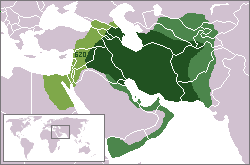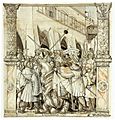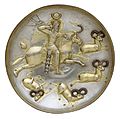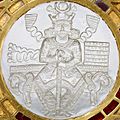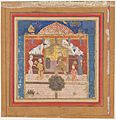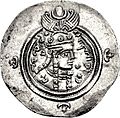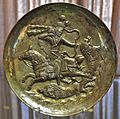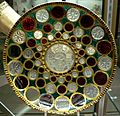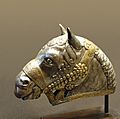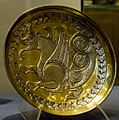Sassanid Empire facts for kids
Quick facts for kids
Sasanian Empire
Ērānshahr
|
|||||||||||||||||||||||||||||||||||||||||||||||
|---|---|---|---|---|---|---|---|---|---|---|---|---|---|---|---|---|---|---|---|---|---|---|---|---|---|---|---|---|---|---|---|---|---|---|---|---|---|---|---|---|---|---|---|---|---|---|---|
| 224–651 | |||||||||||||||||||||||||||||||||||||||||||||||
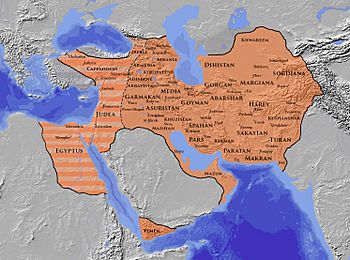
The Sasanian Empire at its greatest extent c. 620, under Khosrow II
|
|||||||||||||||||||||||||||||||||||||||||||||||
| Capital |
|
||||||||||||||||||||||||||||||||||||||||||||||
| Common languages |
|
||||||||||||||||||||||||||||||||||||||||||||||
| Religion |
|
||||||||||||||||||||||||||||||||||||||||||||||
| Government | Feudal monarchy | ||||||||||||||||||||||||||||||||||||||||||||||
| Shahanshah | |||||||||||||||||||||||||||||||||||||||||||||||
|
• 224–241
|
Ardashir I (first) | ||||||||||||||||||||||||||||||||||||||||||||||
|
• 632–651
|
Yazdegerd III (last) | ||||||||||||||||||||||||||||||||||||||||||||||
| Historical era | Late Antiquity | ||||||||||||||||||||||||||||||||||||||||||||||
| 28 April 224 | |||||||||||||||||||||||||||||||||||||||||||||||
|
• The Iberian War
|
526–532 | ||||||||||||||||||||||||||||||||||||||||||||||
|
• Climactic Roman–Persian War of 602–628
|
602–628 | ||||||||||||||||||||||||||||||||||||||||||||||
|
• Civil war
|
628–632 | ||||||||||||||||||||||||||||||||||||||||||||||
| 633–651 | |||||||||||||||||||||||||||||||||||||||||||||||
| 651 | |||||||||||||||||||||||||||||||||||||||||||||||
| Area | |||||||||||||||||||||||||||||||||||||||||||||||
| 550 | 3,500,000 km2 (1,400,000 sq mi) | ||||||||||||||||||||||||||||||||||||||||||||||
|
|||||||||||||||||||||||||||||||||||||||||||||||
The Sasanian Empire, also known as the Sasanian Dynasty or Persia, was a powerful empire that ruled from 224 AD to 651 AD. It was located in what is now Iran and many surrounding areas.
The Sasanian Empire took over from the Parthian Empire. For over 400 years, it was one of the two biggest powers in Western Asia. The other major power was the Roman Empire, which later became the Byzantine Empire.
Contents
The King of Kings
The Sasanian dynasty was started by a ruler named Ardashir I. He defeated the last Parthian king, Artabanus IV. The empire ended when its last ruler, Yazdegerd III, lost a long fight against the early Arab Caliphate. This was the first of the Islamic empires.
The Sasanian Empire was very large. It included all of modern-day Iran and Iraq. It also covered parts of Armenia, Afghanistan, Turkey, Syria, Pakistan, Caucasia, Central Asia, and Arabia.
Many people see the Sasanian era as a very important time in Iranian history. During this period, Persian civilization reached its highest point. It was the last great Iranian Empire before the Muslim conquest and the spread of Islam.
Persia had a big influence on the Roman world during Sasanian times. The Romans even saw the Sasanian Persians as equals. The Roman Emperor would write letters to the Persian Shahanshah, calling him "my brother."
The Sasanian culture spread far beyond its borders. It reached places like Western Europe, Africa, China, and India. It also played a key role in shaping medieval art in both Europe and Asia. This influence continued into the early Islamic world. Many parts of what became known as Islamic culture, like architecture and writing, were inspired by the Sasanian Persians.
Why the Empire Fell
In 632 AD, Yazdegerd III, a grandson of Khosrau I, became the new ruler. In the same year, Arab tribes, united by Islam, began raiding Persian lands. Both the Byzantines and the Persians were tired from years of war.
The Sasanian Empire was also weakened by several problems:
- Its economy was struggling.
- People had to pay very high taxes.
- There was religious unrest among different groups.
- Society was very strict, with people stuck in their social classes.
- Local landholders were gaining too much power.
- Rulers changed very often, causing instability.
These problems made it easier for the Islamic armies to conquer Persia. The Sasanians were never able to put up a strong fight against the Arab armies.
Key Moments in Sasanian History
Here are some important events that happened during the Sasanian Empire:
Early Years and Expansion
- 226–241 AD: Ardashir I rules.
- 224–226: The Parthian Empire is overthrown.
- 229–232: War with Rome begins.
- Zoroastrianism becomes the official religion again.
- 241–271 AD: Shapur I rules.
- 241–244: War with Rome.
- 252–261: Another war with Rome. The Roman emperor Valerian is captured.
- 215–271: Mani, who started the religion of Manichaeism, lives during this time.
Challenges and Conflicts
- 271–301 AD: A time of many struggles for power among different rulers.
- 283: War with Rome. The Romans attack and take the capital city of Ctesiphon.
- 296-298: War with Rome. Persia gives five provinces east of the Tigris River to Rome.
- 309–379 AD: Shapur II "the Great" rules.
- 337–350: First war with Rome, with little success for Persia.
- 359–363: Second war with Rome. Rome returns the provinces east of the Tigris and gives Nisibis and Singara to Persia.
- 387: Armenia is divided between Roman and Persian control.
- 399–420 AD: Yazdegerd I "the Sinner" rules.
- 409: Christians are allowed to worship publicly and build churches.
- 416–420: Christians are persecuted as Yazdegerd changes his mind.
Later Rulers and Decline
- 420–438 AD: Bahram V rules.
- 420–422: War with Rome.
- 424: The Eastern Church declares itself independent from Constantinople.
- 428: The Persian part of Armenia becomes part of the Sasanian Empire.
- 438–457 AD: Yazdegerd II rules.
- 441: War with Rome.
- 449-451: Armenian revolt.
- 482-483: Armenian and Iberian revolt.
- 483: Christians are granted religious tolerance.
- 484: Peroz I is defeated and killed by the Hephthalites.
- 491: Armenian revolt. The Armenian Church rejects the Council of Chalcedon.
- Nestorian Christianity becomes the main Christian group in the Sasanian Empire.
- 502-506: War with Constantinople.
- 526-532: War with Constantinople.
- 531–579 AD: Khosrau I, "with the immortal soul" (Anushirvan), rules.
- 540–562: War with Constantinople.
- 572-591: War with Constantinople. Persia gives much of Armenia and Iberia to Constantinople.
- 590–628 AD: Khosrau II rules.
- 603–628: War with Byzantium. Persia takes over Byzantine Mesopotamia, Syria, Palestine, Egypt, and the Transcaucasus. However, Byzantine forces push them back to their original borders.
- 610: Arabs defeat a Sasanian army at Dhu-Qar.
- 626: An unsuccessful attack on Constantinople by combined Sasanian, Avar, and Slavic forces.
- 627: Byzantine Emperor Heraclius invades Assyria and Mesopotamia. Persian forces are decisively defeated at the battle of Nineveh.
- 628–632: A confusing time with many different rulers.
- 632–642 AD: Yazdegerd III rules.
- 636: A major Sasanian defeat at the Battle of al-Qādisiyyah during the Islamic conquest of Iran.
- 642: The Arabs achieve their final victory when the Persian army is destroyed at Nahavand.
- 651: The last Sasanian ruler, Yazdegerd III, is killed in Merv, ending the dynasty. His son Pirooz and many others go into exile in China.
Images for kids
-
Initial coinage of founder Ardashir I, as King of Persis Artaxerxes (Ardaxsir) V. c. 205/6–223/4 CE. Obv: Bearded facing head, wearing diadem and Parthian-style tiara, legend "The divine Ardaxir, king" in Pahlavi. Rev: Bearded head of Papak, wearing diadem and Parthian-style tiara, legend "son of the divinity Papak, king" in Pahlavi.
-
1840 illustration of a Sasanian relief at Firuzabad, showing Ardashir I's victory over Artabanus IV and his forces.
-
Rock relief of Ardashir I receiving the ring of kingship by the Zoroastrian supreme god Ahura Mazda.
-
Rock-face relief at Naqsh-e Rostam of Persian emperor Shapur I (on horseback) capturing Roman emperor Valerian (standing) and Philip the Arab (kneeling), suing for peace, following the victory at Edessa.
-
The Humiliation of Valerian by Shapur (Hans Holbein the Younger, 1521, pen and black ink on a chalk sketch, Kunstmuseum Basel)
-
The spread of Manichaeism (300–500)
-
Bust of Shapur II (r. 309 – 379)
-
16px]] and "Alchono" (αλχοννο) in Bactrian script on the obverse. Dated 400–440.
-
Bahram V is a great favourite in Persian literature and poetry. "Bahram and the Indian princess in the black pavilion." Depiction of a Khamsa (Quintet) by the great Persian poet Nizami, mid-16th-century Safavid era.
-
Plate of Peroz I hunting argali
-
Plate of a Sasanian king hunting rams, perhaps Kavad I (r. 488 – 496).
-
Plate depicting Khosrow I.
-
15th-century Shahnameh illustration of Hormizd IV seated on his throne.
-
Coin of Khosrow II.
-
The Siege of Constantinople in 626 by the combined Sasanian, Avar, and Slavic forces depicted on the murals of the Moldovița Monastery, Romania
-
Queen Boran, daughter of Khosrau II, the first woman and one of the last rulers on the throne of the Sasanian Empire, she reigned from 17 June 629 to 16 June 630
-
Umayyad Caliphate coin imitating Khosrau II. Coin of the time of Mu'awiya I ibn Abi Sufyan. BCRA (Basra) mint; "Ubayd Allah ibn Ziyad, governor". Dated AH 56 = 675/6. Sasanian style bust imitating Khosrau II right; bismillah and three pellets in margin; c/m: winged creature right / Fire altar with ribbons and attendants; star and crescent flanking flames; date to left, mint name to right.
-
A fine cameo showing an equestrian combat of Shapur I and Roman emperor Valerian in which the Roman emperor is seized following the Battle of Edessa, according to Shapur's own statement, "with our own hand", in 260
-
Egyptian woven pattern woolen curtain or trousers, which was a copy of a Sasanian silk import, which was in turn based on a fresco of King Khosrau II fighting Axum Ethiopian forces in Yemen, 5–6th century
-
Foreign dignitary drinking wine, on ceiling of Cave 1, at Ajanta Caves, possibly depicting the Sasanian embassy to Indian king Pulakesin II (610–642), photograph and drawing.
-
Taq-i Kisra, the facade of the Sasanian palace in the capital Ctesiphon. The city developed into a rich commercial metropolis. It may have been the most populous city of the world in 570–622.
-
Plate of a Sasanian king, located in the Azerbaijan Museum in Iran.
-
A bowl with Khosrau I's image at the center
-
Sasanian sea trade routes
-
The Sasanians developed an accurate, phonetic alphabet to write down the sacred Avesta
-
Sasanian-era cornelian gem, depicting Abraham advancing towards Isaac with a knife in his hands. A ram is depicted to the right of Abraham. Middle Persian (Pahlavi) inscription ZNH mwdly l’styny. Created 4th-5th century AD
-
A Sasanian fortress in Derbent, Russia (the Caspian Gates)
-
"Parsees of Bombay" a wood engraving, c. 1873
See also
 In Spanish: Imperio sasánida para niños
In Spanish: Imperio sasánida para niños




